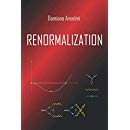Quantum gravity
We reconsider perturbative unitarity in quantum field theory and upgrade several arguments and results. The minimum assumptions that lead to the largest time equation, the cutting equations and the unitarity equation are identified. Using this knowledge and a special gauge, we give a new, simpler proof of perturbative unitarity in gauge theories and generalize it to quantum gravity, in four and higher dimensions. The special gauge interpolates between the Feynman gauge and the Coulomb gauge without double poles. When the Coulomb limit is approached, the unphysical particles drop out of the cuts and the cutting equations are consistently projected onto the physical subspace. The proof does not extend to nonlocal quantum field theories of gauge fields and gravity, whose unitarity remains uncertain.
Phys. Rev. D 94 (2016) 025028 | DOI: 10.1103/PhysRevD.94.025028
The properties of quantum gravity are reviewed from the point of view of renormalization. Various attempts to overcome the problem of nonrenormalizability are presented, and the reasons why most of them fail for quantum gravity are discussed. Interesting possibilities come from relaxing the locality assumption, which can inspire the investigation of a largely unexplored sector of quantum field theory. Another possibility is to work with infinitely many independent couplings, and search for physical quantities that only depend on a finite subset of them. In this spirit, it is useful to organize the classical action of quantum gravity, determined by renormalization, in a convenient way. Taking advantage of perturbative local field redefinitions, we write the action as the sum of the Hilbert term, the cosmological term, a peculiar scalar that is important only in higher dimensions, plus invariants constructed with at least three Weyl tensors. We show that the FRLW configurations, and many other locally conformally flat metrics, are exact solutions of the field equations in arbitrary dimensions $d>3$. If the metric is expanded around such configurations the quadratic part of the action is free of higher-time derivatives. Other well-known metrics, such as those of black holes, are instead affected in nontrivial ways by the classical corrections of quantum origin.
Mod. Phys. Lett. A 30 (2015) 1540004 | DOI: 10.1142/S0217732315400040
The classical action of quantum gravity, determined by renormalization, contains infinitely many independent couplings and can be expressed in different perturbatively equivalent ways. We organize it in a convenient form, which is based on invariants constructed with the Weyl tensor. We show that the FLRW metrics are exact solutions of the field equations in arbitrary dimensions, and so are all locally conformally flat solutions of the Einstein equations. Moreover, expanding the metric tensor around locally conformally flat backgrounds the quadratic part of the action is free of higher derivatives. Black-hole solutions of Schwarzschild and Kerr type are modified in a non-trivial way. We work out the first corrections to their metrics and study their properties.
JHEP 1305 (2013) 028 | DOI: 10.1007/JHEP05(2013)028
We prove the renormalizability of various theories of classical gravity coupled with interacting quantum fields. The models contain vertices with dimensionality greater than four, a finite number of matter operators and a finite or reduced number of independent couplings. An interesting class of models is obtained from ordinary power-counting renormalizable theories, letting the couplings depend on the scalar curvature R of spacetime. The divergences are removed without introducing higher-derivative kinetic terms in the gravitational sector. The metric tensor has a non-trivial running, even if it is not quantized. The results are proved applying a certain map that converts classical instabilities, due to higher derivatives, into classical violations of causality, whose effects become observable at sufficiently high energies. We study acausal Einstein-Yang-Mills theory with an R-dependent gauge coupling in detail. We derive all-order formulas for the beta functions of the dimensionality-six gravitational vertices induced by renormalization. Such beta functions are related to the trace-anomaly coefficients of the matter subsector.
Class. Quant. Grav. 24 (2007) 1927 | DOI: 10.1088/0264-9381/24/8/003
arXiv: hep-th/0611131
I prove that classical gravity coupled with quantized matter can be renormalized with a finite number of independent couplings, plus field redefinitions, without introducing higher-derivative kinetic terms in the gravitational sector, but adding vertices that couple the matter stress-tensor with the Ricci tensor. The theory is called “acausal gravity”, because it predicts the violation of causality at high energies. Renormalizability is proved by means of a map M that relates acausal gravity with higher-derivative gravity. The causality violations are governed by two parameters, a and b, that are mapped by M into higher-derivative couplings. At the tree level causal prescriptions exist, but they are spoiled by the one-loop corrections. Some ideas are inspired by the usual treatments of the Abraham-Lorentz force in classical electrodynamics.
JHEP 0701 (2007) 062 | DOI: 10.1088/1126-6708/2007/01/062
arXiv:hep-th/0605205
In flat space, $\gamma_5$ and the epsilon tensor break the dimensionally continued Lorentz symmetry, but propagators have fully Lorentz invariant denominators. When the Standard Model is coupled with quantum gravity $\gamma_5$ breaks the continued local Lorentz symmetry. I show how to deform the Einstein lagrangian and gauge-fix the residual local Lorentz symmetry so that the propagators of the graviton, the ghosts and the BRST auxiliary fields have fully Lorentz invariant denominators. This makes the calculation of Feynman diagrams more efficient.
Phys. Lett. B 596 (2004) 90 | DOI: 10.1016/j.physletb.2004.06.089
arXiv:hep-th/0404032
As it stands, quantum gravity coupled with matter in three spacetime dimensions is not finite. In this paper I show that an algorithmic procedure that makes it finite exists, under certain conditions. To achieve this result, gravity is coupled with an interacting conformal field theory $C$. The Newton constant and the marginal parameters of $C$ are taken as independent couplings. The values of the other irrelevant couplings are determined iteratively in the loop- and energy-expansions, imposing that their beta functions vanish. The finiteness equations are solvable thanks to the following properties: the beta functions of the irrelevant couplings have a simple structure; the irrelevant terms made with the Riemann tensor can be reabsorbed by means of field redefinitions; the other irrelevant terms have, generically, non-vanishing anomalous dimensions. The perturbative expansion is governed by an effective Planck mass that takes care of the interactions in the matter sector. As an example, I study gravity coupled with Chern-Simons $U(1)$ gauge theory with massless fermions, solve the finiteness equations and determine the four-fermion couplings to two-loop order. The construction of this paper does not immediately apply to four-dimensional quantum gravity.
Nucl.Phys. B687 (2004) 124-142 | DOI: 10.1016/j.nuclphysb.2004.03.024
arXiv:hep-th/0309250
In three spacetime dimensions, where no graviton propagates, pure gravity is known to be finite. It is natural to inquire whether finiteness survives the coupling with matter. Standard arguments ensure that there exists a subtraction scheme where no Lorentz-Chern-Simons term is generated by radiative corrections, but are not sufficiently powerful to ensure finiteness. Therefore, it is necessary to perform an explicit (two-loop) computation in a specific model. I consider quantum gravity coupled with Chern-Simons U(1) gauge theory and massless fermions and show that renormalization originates four-fermion divergent vertices at the second loop order. I conclude that quantum gravity coupled with matter, as it stands, is not finite in three spacetime dimensions.
Nucl.Phys. B687 (2004) 143-160 | DOI: 10.1016/j.nuclphysb.2004.03.023

 Quantum Gravity
Quantum Gravity 


